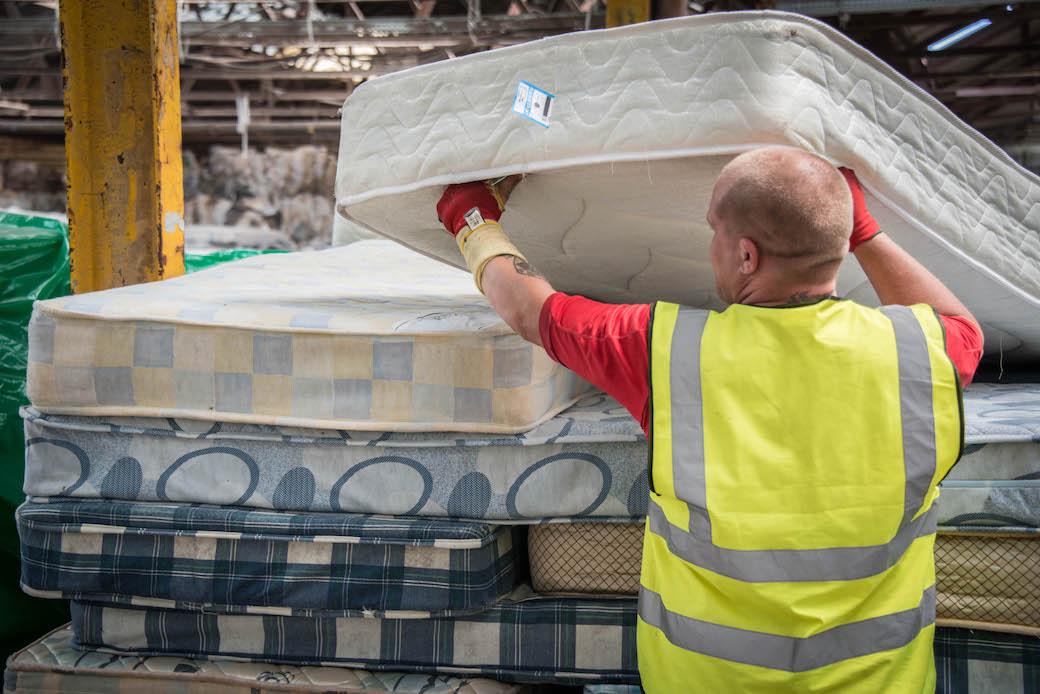Home Mattress Recycling
Need to recycle your old mattress?
Our sister company, The Mattress Recycling People, can take care of it!

The UK Government has pledged, through the Net Zero Strategy, the near elimination of municipal biodegradable waste to landfill from 2028. They have also committed to halve the residual waste per person by 2042, stated in the Environment Act 20211.
However, existing regulations create an obstacle in the recycling and reusing process as the removal of a label makes an item unable to be reused or means that it requires retesting. This leaves many commodities, such as mattresses, in limbo – usually leaving consumers to give up on responsible disposal and resorting to landfill as many are unaware that mattresses missing fire labels can be recycled via retailers, mattress recycling businesses, waste management companies and local councils.
As the Government looks to halve Britain’s waste, challenges across the industry must be tackled to create a more sustainable approach and achieve its targets.
Fire labels provide reassurance to retailers and consumers that the items have passed specific fire safety tests – they keep people safe.
Introduced in 1988, fire labels are legally required to be on soft furnishings and some furniture items before sale, to show that the item complies with British Fire Safety Regulations.
Upholstered items can contain foams, fillings and other materials that could be flammable and because of this, items must have set levels of fire resistance determined through a series of flammability tests.
Mattresses, beds and divans must have a fire label sewn in, which refers to BS71772 – the British safety specification for resistance to ignition of mattresses, divans and bed bases.
Fire safety labels are sewn onto mattresses to make them more difficult to remove. However some consumers manually remove them. The removal of a fire label means that the mattress can not be used in its current form again. If a fire label is removed from a mattress before returning in a comfort guarantee, there are several implications:
Legal and Regulatory Issues: It’s illegal to sell or donate mattresses that don’t have a fire safety label. For retailers offering rejuvenated mattresses, this could be particularly problematic. If these mattresses are resold without a fire label, the retailer could face significant legal penalties.
Reputation Damage: Beyond legal concerns, selling or distributing mattresses without required safety labels can significantly damage a retailer’s reputation. Consumers trust retailers to provide safe products, and breaches of this trust can have long-term negative impacts on customer relationships and brand image.
Supply Chain Integrity: Retailers need to trust their supply chain. If mattresses are arriving without the required labels or if labels are being removed during some refurbishment process, it could indicate deeper issues with the supply chain’s integrity and compliance.
Waste and Environmental Concerns: If a retailer cannot sell mattresses without fire labels, their alternative option is to dispose of them. This can increase waste and lead to environmental concerns, especially if many mattresses end up in landfills.
TFR Group offers a mattress rejuvenation service for comfort guarantee returns that protects brand integrity, ensuring that mattresses are legally compliant.
For those that do not pass compliance checks, for example if they are missing a fire label, or for mattresses past the comfort night guarantee, TFR Group responsibility recycles the mattresses.
By providing clearer guidelines and educating consumers on the importance of fire safety labels and the implications of removing them, it could help to reduce issues in the future.
Collaboration with furniture manufacturers, retailers and recyclers could also create more durable or tamper-evident labels to eliminate the issue, while digital or QR codes could be introduced to replace or complement physical labels. This would ensure information is always accessible, especially as our world becomes more and more digital.
As we all focus on becoming more sustainable, it is the perfect time for the furniture industry, recycling businesses and regulatory bodies to work together to establish clearer guidelines and foster a shared responsibility. By collaborating it can help produce a sustainable solution that works for everyone.
Now is a key time for all stakeholders to take action, from legislators to manufacturers and recycling businesses, working together towards a more sustainable solution from digital labels to wider awareness and education campaigns.
If you are looking to introduce a sustainable solution into your business, get in touch today.
"*" indicates required fields
Need to recycle your old mattress?
Our sister company, The Mattress Recycling People, can take care of it!
X